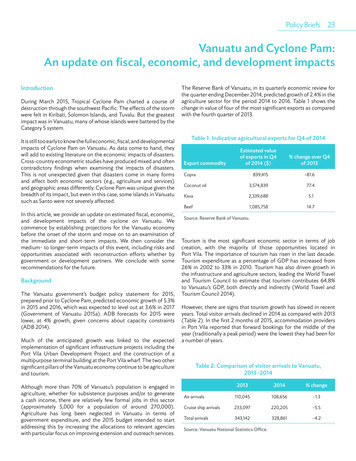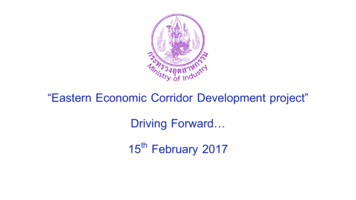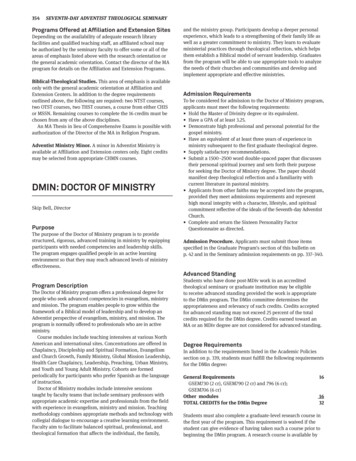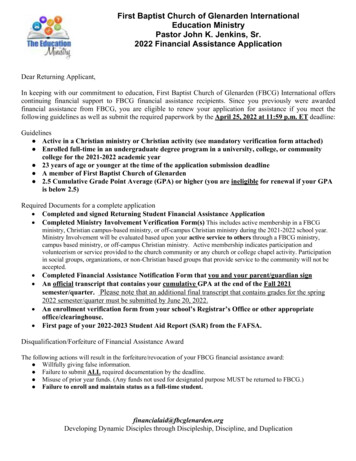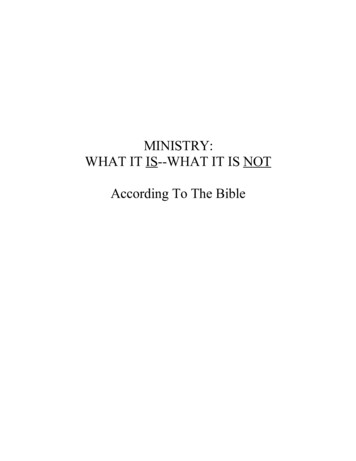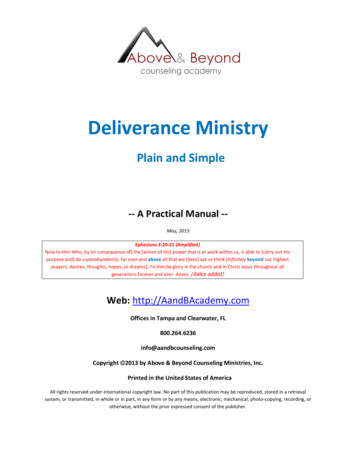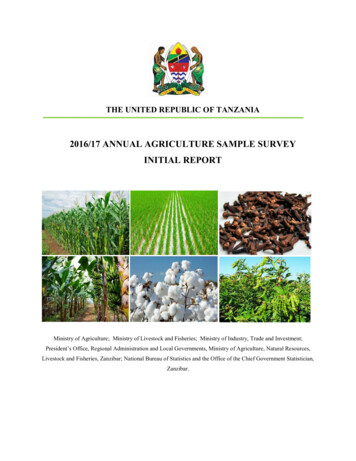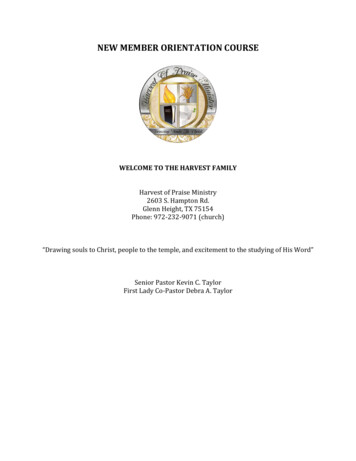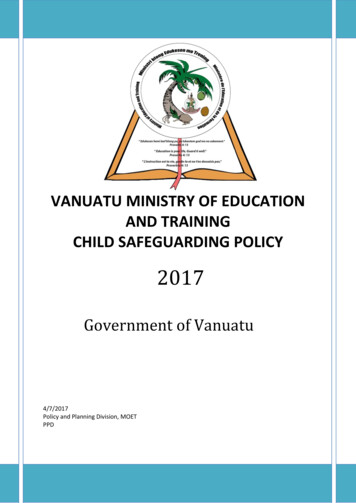
Transcription
VANUATU MINISTRY OF EDUCATIONAND TRAININGCHILD SAFEGUARDING POLICY2017Government of Vanuatu4/7/2017Policy and Planning Division, MOETPPD
ContentsABBREVIATIONS . 2Definitions . 3Forward . 6Acknowledgement . 7Child Safeguarding Policy . 81.1: The Ministry of Education and Training . 81.2: Policy Commitment to Protect Children . 81.3: Guiding Principles . 91.4: Scope of Policy . 101.5: Child Safeguarding Policy Implementation Strategy . 101.6: Information on statements to be signed by Staff, Teachers, PEB, EA, Volunteers &Stakeholders . 111.7: Information on Child Safeguarding Reporting Procedure . 111.8: Implementation and Review of the Policy . 122.0: Appendix A. Child Safeguarding Reporting Process . 132.1: Appendix B. Child Safeguarding Code of Conduct . 14Child Safeguarding Code of Conduct . 142.2 Commitment and Agreement to Comply. 152.3: Appendix C. Child Safeguarding Reporting Form . 173: Annex . 213.1 References . 213.2: Two Years Implementing Strategies . 221 P a g eMOET Child Protection Policy and Procedures
UNICEFVESPZCAChild Safeguarding Focal PointDepartment of Foreign Affairs & Trade, AustraliaEducation AuthorityEarly Childhood Care & EducationHuman Resource DevelopmentMinistry of Foreign Affairs & Trade, New ZealandMinistry of Education and TrainingProvincial Education BoardRegional Rights Resource TeamUnited Nations Convention on the Rights of the ChildUnited Nations Children’s FundVanuatu Education Support ProgramZone Curriculum Advisers2 P a g eMOET Child Protection Policy and Procedures
DefinitionsChild: The Ministry of Education and Training uses the United Nations Convention on the Rights ofChild (UNCRC) definition of a child, which is any person under the age of 18 years. In Vanuatu a childcan also be referred to as a minor.School: refers to and includes all Early Childhood Education and Care centers, Child/Day Care Centers,Primary, secondary and Tertiary institution.Student: for the purpose of this policy the term ‘student’ refers to all children under the age of 18including those who are above 18 years of age but who are still in secondary schools.Best interest of the child: providing what is best for the child whilst taking into consideration theirresponsibilities to their parents, families and community, except in situations wheredecisions/responsibilities put children at risk of harm or further harm.Childhood: Childhood is defined as the period of time before the 18th birthday of a child. Ideally, duringthis period, the child should grow and develop with the love and protection of their family and anextended community of caring adults.Child Protection: The term used to describe the responsibilities and activities or initiatives designedto protect children from the risk of abuse, exploitation, neglect, violence, maltreatment, injury andother harm due to the situation in which they are living or find themselves. .In the context of this Policy, child protection can be divided into 2 distinct but overlapping areas:a) Child Safeguarding - the responsibility that the Ministry of Education and Training has to ensure thatits staff, and its operations do no harm to children. This means putting in place mechanisms to ensurethat children are not put at risk of abuse, injury, violence or other harm; and that any concerns ofabuse are reported and responded to appropriately.b) Child Protection - the work that the Ministry of Education and Training undertakes (at local,provincial and national levels) to improve the protection situation in general for children who live inVanuatu, as guided by the National Child Protection Policy of the Ministry of Justice and CommunityServices. This includes working holistically, in an integrated way, and in close collaboration and coordination with key stakeholders (including children themselves) across different Ministries andsectors (e.g. Health, Justice and Community Services, the Religious community, Kastom, etc.); withina framework of awareness, prevention, early identification and early intervention of child protectionconcerns, reporting of concerns, and appropriate response and support which puts children’s bestinterests at the center.Whilst the focus of this Policy is on Part (a), the role of the MOET in supporting the work described inPart (b) is critical to improving the overall protection situation for children in the country.Child Abuse: All forms of physical and/or emotional ill-treatment resulting in actual or potential pain,injury, harm or threatened harm to the child's health, survival, development or dignity in the contextof a relationship of responsibility, trust or power including by those who are responsible for theirwelfare. This includes physical, sexual and emotional abuse, chronic/serious neglect and negligent3 P a g eMOET Child Protection Policy and Procedures
treatment, commercial or other exploitation including child labor, sexual exploitation, bullying, tortureand domestic violence1.Forms of Child Abuse: 1Physical Abuse: Physical abuse is commonly characterized by practices such as: Kicking, punching, hitting (including using open hands, fists and implements such as belts andsticks) Shaking (particularly young babies) Biting or pulling of/out hair Burning (intentionally using cigarettes, irons, heaters etc. to harm) Alcohol or other drugs administration and/or misuse (including illicit and prescribed drugs) Genital mutilationEmotional Abuse: Emotional abuse is a chronic pattern of emotional maltreatment directed at thechild which results in the child child’s esteem, social competence and emotional developmentbeing undermined or eroded. Behaviors may include: Devaluing (e.g. through name-calling, insulting) Ignoring Rejecting Corrupting Isolating (such as locking in a closet/room) Terrorizing (e.g. shouting, intimidating, scaring) Domestic violence in the child’s presence.Sexual Abuse: involvement of a child in any sexual activity. Behaviors can include: Using sexually suggestive body or verbal language Exhibitionism, mutual masturbation, oral sex Showing pornographic materials e.g. DVDs, internet, mobile phones Using children in production of pornographic material Penile or other penetration of the genital or anal region Touching a child in any way that he or she does not want, including but not limited totouching of private parts (breast, genital, anal region) Using the internet as a means to gain access to children for sexual purposes either online orin personSexual exploitation - engaging a child in any sexual activity in exchange for money, gifts, food,accommodation, affection, status, preferential treatment, or anything else that they or their familyneeds. This can take place in school, in the home, in the community, online, and includes but is notlimited to child prostitution.Chronic or Serious Neglect: Chronic or serious neglect is characterized by a recurring failure onthe part of the caregiver to provide for the child’s basic needs, even though the caregiver has themeans to provide these. This may include: Inadequate supervision of young children Failure to provide adequate shelter, nutrition, clothing or personal hygiene Failure to provide needed or appropriate healthcare/medical treatmentDrawn from World Health Organisation definition of abuse.4 P a g eMOET Child Protection Policy and Procedures
Failure to reasonably ensure a home or school environment that is free from potentialhazards Forcing the child to leave home or to drop out of school at an early age Allowing a child to engage in chronic truancy Failure to provide the child with emotional support including love and affectionBullying: Bullying is the use of force, threat, or coercion to abuse, intimidate, or aggressivelydominate others. The behavior is often repeated and habitual and usually refers to behaviorbetween children/adolescents.Cyber-bullying : describes acts of bullying where the offender can anonymously use informationand communications technology to harm children in a deliberate and hostile mannerCommercial Exploitation - exploiting a child in activities for the benefit of others and to thedetriment of the child's physical or mental health, education, moral or social-emotionaldevelopment. This includes child labour, which as defined in ILO Convention as work that depriveschildren of their childhood, their potential and their dignity, and is harmful to their physical andmental development.5 P a g eMOET Child Protection Policy and Procedures
ForwardThe Ministry of Education and Training through this policy will provide a clear directive or frameworkto safeguard the welfare of our children within the education sector.This Policy defines the Ministry of Education and Training’s core principles and beliefs on childsafeguarding. It establishes procedures and practices that will be undertaken to meet ourcommitment to keep children safe and to manage suspected cases of child abuse.The purpose of this policy is to inspire breakthroughs in the way our school communities treat childrenand to provide guidelines on the safeguarding of children, young people and vulnerable adults whomthe Ministry of Education and Training serve and/or work within its premises, programs, schools,school zones and school communities from all forms of physical or mental violence, sexual abuse,exploitation, and injury.The work of the Ministry is underpinned by Article 19 of the United Nations Convention on the Rightsof the Child (UNCRC) which states that children should be protected from all forms of physical andmental violence, injury, abuse, neglect, maltreatment and exploitation including sexual abuse.Therefore the Education sector is committed to protecting children, regardless of disability type,gender, race, religious belief, culture and language background, island or country of origin, or Parents’marital status.6 P a g eMOET Child Protection Policy and Procedures
AcknowledgementThe Child Safeguarding Policy has been developed by the MoET Child Safeguarding Policy workingteam that comprises of: MOET Child Protection focal point (Roy Ben), Vanuatu Education SupportProgramme (VESP) Inclusive Officer (Sherol George), Save the Children Australia Senior ChildProtection Specialist (Christine Lipohar), Vanuatu Regional Rights Resource Team (RRRT) CountryOfficer (Donna Marie Purie Narai) and the Program Manager Recovery, DFAT (Liku Jimmy).The Ministry of Education and Training acknowledges the working committee’s commitment and theassistance of the Vanuatu Education Sector Programme (VESP), Save the Children Australia (SCA) andthe Vanuatu Regional Rights Resource Team (RRRT).To ensure that the resources and efforts are directed towards implementing this policy the Ministryof Education and Training consulted a few stakeholders and MOET staff for their input into thisdocument.Therefore the Ministry of Education and Training would like to also acknowledge the following, fortheir assistance in providing feedback and supporting the development of this document: Directors and Staffs of MoETECCE Provincial CoordinatorsMinistry of Justice and Community ServicesDepartment of Foreign Affairs (AusAid)Ministry of Foreign Affairs (NZAID)Vanuatu Society for People with DisabilityVanuatu National Statistics OfficePrincipal and Staffs of Onesua Presbyterian CollegeNorth Efate school PrincipalsNorth Efate CommunityUNICEFSave the Children, AustraliaTeresa Gonzales ECCE Technical Advisor,Elizabeth Emil Mael, Child Desk Officer, Ministry of Justice and Community Services7 P a g eMOET Child Protection Policy and Procedures
Child Safeguarding Policy1.1: The Ministry of Education and TrainingThe Ministry of Education and Training (MOET) is committed to meeting the National and Internationallegal and ethical requirements for child safeguarding. This policy recognizes the particularvulnerabilities that children face to a range of abuses as well as injuries.This Policy defines the Ministry of Education and Training’s core principles and beliefs on childsafeguarding and establishes procedures that will be undertaken to meet our commitment to childsafeguarding including the management of suspected and/or reported cases of child abuse.VisionAn environment in which every child attains the right to survival, protection, development andparticipation.PurposeTo inspire breakthroughs in the way our school communities treat children; and to provide guidelineson the safeguarding of children whom the Ministry of Education and Training serve and/or work withinits premises, programs, schools, school zones and school communities from injury and all forms ofphysical or mental violence including sexual abuse and exploitation.1.2: Policy Commitment to Protect ChildrenThe Ministry of Education and Training is committed to protecting children, regardless of disabilitytype, gender, race, religious belief, culture and language background, island or country of origin, orparents’ marital status.This Policy is underpinned by the United Nations Convention on the Rights of the Child (UNCRC), whichstates that children should be protected from all forms of physical and mental violence, injury, abuse,neglect, maltreatment and exploitation including sexual abuse. While this policy is committed toprotecting all children from any form of maltreatment, as a component of upholding their Rights ingeneral, as stated in UNCRC, it is also aware of the responsibilities that are associated with theseRights. It is the children’s responsibility to abide to established rules and guidelines, as rights andresponsibilities go hand in hand.The Ministry of Education and Training shall promote and protect the following rights of the children:a) Right to a safe and healthy work or school environment – this includes the following: a schoolenvironment resilient to hazards, appropriate safety advice to staff and students, counseling servicesthat are relevant and appropriate, healthy school programsb) Right to protection from all forms of physical and mental violence, injury, abuse, bullying, cyberbullying, neglect, maltreatment and exploitation including sexual abuse (UNCRC, Article 19). Thismeans putting in place mechanisms to protect children from being put at risk in the first place; andto ensure that any concerns are reported and responded to or referred appropriately, includingreferral to relevant service providers for further care and support of the child.8 P a g eMOET Child Protection Policy and Procedures
c) Right to participation (UNCRC, Article 12) – in the context of this Policy, children have the rightand should be encouraged to express their views on how to make schools safer in general; and toexpress their views on developing systems that will enable children to safely report concerns abouthazards or about conduct of personnel.d) Observance of all other rights in the constitution of the Republic of Vanuatu and the UnitedNation declaration of Human Rights.The Ministry of Education and Training Human Resource Development (HRD) Policies will incorporatechild safeguarding provisions to address the following key standards:a) Ensuring that the recruitment and training process2 for Teaching Services Staff, Teachers andPublic Servants includes checks on candidates’ suitability for working with children.b) Ensuring that appropriate tools are developed and used for reporting and responding tobreaches of the Policy and its Code of Conduct including suspected cases of child abuse.The MOET will ensure the following systems are in place:a) All partnership agreements with stakeholders3 should clearly reflect the Ministry of Educationand Training’s expectations of the Stakeholder to ensure children are protectedb) All MOET Staff, and Teaching Service Staff and volunteers should be provided with mandatoryorientation/training to the Child Safeguarding Policy; should be expected to uphold itsrequirements, including the mandatory requirement to report concerns; and will be held toaccountc) All Child Safeguarding Focal Points will be trained and equipped to provide appropriateresponse to children suspected to be victims/survivors of abused) All MOET Staff, and Teaching Service Staff and volunteers will be provided with updatedinformation on the status of existing child safeguarding policies and programs, laws and keyadvocacy messages.e) MOU to be signed with other organizations to observe and implement the Child SafeguardingPrinciples.1.3: Guiding PrinciplesThe Ministry of Education and Training’s commitment to child safeguarding is based on the followingprinciples: Promoting and protecting the best interests of children 4 at all times, while taking intoconsideration their responsibilitiesRespecting and treating all children with dignity at all timesCarefully upholding confidentiality in respect of all parties (child, witnesses, allegedperpetrator) in relation to a suspicion or allegation of misconductUnderstanding that child safeguarding is a shared responsibility between the Ministry, itspartners and the school communities in which it works2may Include police, medical and reference checks“Stakeholders” includes all listed under 1.44Refer to definition39 P a g eMOET Child Protection Policy and Procedures
Creating a safe and healthy environment for all children through the cooperation of all staff,teachers, volunteers and the school communities that the Ministry serves andEnsuring that the views of children and young people are considered to inform ChildSafeguarding Policy implementation and program development1.4: Scope of PolicyThe Policy applies to the following; Ministry of Education and Training StaffTeaching Service StaffVolunteers undertaking their work under the umbrella of MoET (local and international – JICA,Peace Corps, SCA, VSA, UNICEF, France Volunteers and others)Provincial Education Board (PEB) membersSchool Council membersTechnical Advisors or Consultants contracted or associated with MoETPartner organization and managing contractors within the Ministry of Education and TrainingOther Government departments staff in regular contact with the Ministry of Education andTraining programsPeople visiting Schools including researchers, journalist, donors, Non-GovernmentOrganizations.Members of the school community (this includes students, parents/guardians, ancillary staffand community leaders)1.5: Child Safeguarding Policy Implementation Strategy5The Child Safeguarding Policy and procedures will be implemented through:a) Child safeguarding capacity building – the MOET child Safeguarding desk officer will enhanceawareness of child safeguarding and child protection issues amongst staff, teachers,volunteers, and other stakeholders through policy promotion, collaboration, advocacy andongoing education and training. This will include providing information to students about theconduct they can expect of teachers and other personnel, and how to raise concerns.b) Standards of conduct which outline acceptable and unacceptable ways of working withchildrenc) Compliance – staff, teachers, volunteers and other stakeholders will be briefed prior to signinga written statement agreeing to comply with the Child Safeguarding Policy and procedures.d) Mandatory reporting requirement - by all persons falling under the scope of this Policy, forany alleged or suspected case of child abuse.e) The establishment of a child-friendly complaints’ and feedback mechanism within each schoolto enable children themselves to raise concerns safely, confidentially and without fear ofretribution.5See Annex 3.210 P a g eMOET Child Protection Policy and Procedures
f)The management of reports, suspicions or allegations of misconduct: professionally,confidentially, as quickly as possible, in the best interests of the child, and in line with thecountry’s specific legislative requirements.g) Child Safeguarding Focal Point (CSFP) – CSFP will be appointed and supported in the Ministryof Education and Training schools, school zones and Provincial Education Offices to promotechild safeguarding and act as a first point of contact for any reports of alleged or suspectedchild abuse or other serious breaches of the Child Safeguarding Policy and its Code of Conduct.h) Risk Management – effective strategies to prevent injury as well as child abuse will beincorporated in all the Ministry’s program designs, activities and Education in Emergencyresponses through risk assessment / mitigation processes.i) Recruitment and staff management practices - Prospective and current staff will be screenedand monitored for their suitability to work with children, to help ensure that the Ministry doesnot employ or retain people who pose a risk to childrenj) Child Safeguarding Guidelines and Procedures - Detailed guidelines and procedures will beavailable to assist staff, teachers and volunteers to implement and meet specificrequirements of the Child Safeguarding Policy.k) School disciplinary programs that reflect and incorporate the requirements of the ChildSafeguarding Policy1.6: Information on statements to be signed by Staff, Teachers, PEB, EA,Volunteers & StakeholdersAs stated in Section 1.5 (c) all personnel falling within the scope of this Policy must sign theiragreement to comply with the Child Safeguarding Policy, on the form set out in Sections 2.1 and 2.2,Appendix B, prior to commencing employment, or for those already in a contractual agreement withthe MoET, at the commencement of this Policy.Statements signed by staff and other stakeholders must be returned to the Human Resource Officer,with a copy to the Child Safeguarding Focal Point at the Ministry of Education and Training forsafekeeping.1.7: Information on Child Safeguarding Reporting ProcedureThe detailed procedures for reporting and acting on child safeguarding concerns, includinginvestigations are provided and must be followed. In summary however:If a staff member hears, suspects, or witnesses: child abuse or other serious breach of the Child Safeguarding Policy by staff, teachers, othersMoET stakeholders abuse of a child by someone external to the school (e.g. family or community member) serious injury to a child (e.g. within the school environment)It is mandatory for the procedures outlined in Section 2, Appendix A to be followed. This includesfilling out the Child Safeguarding Reporting Form (see 2.3 Appendix C), and forwarding that reportaccordingly, including to the MoET Child Safeguarding Focal Point.11 P a g eMOET Child Protection Policy and Procedures
The decision to undertake an internal investigation will be made by Director Education Services andin accordance with MoET written procedures on investigating child safeguarding concerns. In orderto ensure integrity of the process, no person should commence questioning of the alleged victim,perpetrator or any witnesses without appropriate authorization.The officer in charge must provide information on the action taken in the form of additional notes,before forwarding the form and the attached notes to the next officer in charge (according to theChild-Safe Guarding Reporting Process). It is a MUST for all reports to be forwarded to the MoETChild Safeguarding Focal Point (CSFP).1.8: Implementation and Review of the PolicyThe establishment of systems required to implement this Policy will be undertaken through thedevelopment and progress monitoring of an implementation action plan.Compliance to the behavioral requirements set out in this Policy will monitored on an ongoing basisthrough transparent processes including the establishment of school-based feedback andcomplaints’ mechanisms. .The Policy will be reviewed at least every two years.12 P a g eMOET Child Protection Policy and Procedures
2.0: Appendix A. Child Safeguarding Reporting ProcessChild Safeguarding Reporting Process –Staff, Teachers, ZCAs,Volunteers, PEBs etc.Parents, guardians,adultsWho can report?Child or young personWhat to report?Allegations, disclosures, suspicions or observations of child abuse or other breaches of the Child SafeguardingPolicy and its Code of Conduct by staff, teachers, others MoET stakeholders, etc; or abuse of a child bysomeone external to the school; or a serious injury to a child (e.g. within or outside the school environment)When to report?All concerns that come to the attention of staff must be reported within 24 hours, or as soon aspractically possible. If it is deemed that the child requires immediate medical intervention such as in acase of physical or sexual abuse, the child must be taken to the nearest Health center for medicalexamination or the nearest police station for safety reasons if needed.Any allegations of Policy breaches by staff,teachers, other stakeholders etc. must bereported through this process: SchoolWho to report to?Head/CSFPPEOCSFP in MOETDirector Education Services Police. Note:cases which may be criminal in natureshould be reported to the Police as well aswithin MoET. .Concerns for the safety orwellbeing of any child must bereported to the School Head,Managers, the Director EducationServices and the Child SafeguardingFocal Point.See written procedures to followVictim’s medical, psycho-social, and safety needs assessed and responded to CSFP. Alleged perpetrator’ssafety assessed and responded to CSFP.What will happen?Situation and information will be assessed CSFP, a decision will be made CSFP as to whether aninvestigation is required and if yes, will be undertaken according to MOET procedures. A confidentialreport will be made in compliance with this Policy and/or within the context of local, state and countrylegislation. Principles of confidentiality, best interests of the child, do no harm, timeliness, objectivity,neutrality and respect for all to be followed throughout the process.Victim’s medical, psychosocial, and safety needsassessed and responded toon an ongoing basis, asrequired.If allegation is proven tobe true: performancemanagement orappropriate disciplinaryaction includingsuspension or terminationof employment.If criminalThechild case:mustchildbe taken to the nearest Health center for medical examinationPossible Outcomesprotection report made toPolice (Family Protection Unit)and to the National ChildProtection Desk at theMinistry of Justice.Feedback to be given where possible to the individual who reported the concern as well as thosedirectly involved or affected, protecting confidentiality and privacy. Counseling to be offered ifneeded. Lessons learned from the process discussed and documented for future application.13 P a g eMOET Child Protection Policy and Procedures
2.1: Appendix B. Child Safeguarding Code of ConductChild Safeguarding Code of ConductI, (insert name) agree that in the course of myassociation with the Ministry of Education and Training,I will: Treat all children and students6 with respect regardless of race, colour, sex, language, disability,religion, political or other opinion, national, ethnic or social origin, birth or other status includingmarital status Provide a welcoming, inclusive and safe environment for all children and young people Encourage children or young people to speak up about issues that affect them including any concernsthey might have about maltreatment Take all concerns seriously that are raised by children or others; and take appropriate action as perthe procedures Abstain from using corporal or humiliating punishment on children, but instead use disciplinaryapproaches that are positive and constructive7 Immediately report all suspicions, disclosures, or allegations of child abuse (within or external to theschool system); or any breaches of this Policy, in accordance with the Ministry of Education andTrain
Child: The Ministry of Education and Training uses the United Nations Convention on the Rights of Child (UNCRC) definition of a child, which is any person under the age of 18 years. In Vanuatu a child can also be referred to as a minor. School: refers to and includes all Early Childhood Education and Care centers, Child/Day Care Centers,

